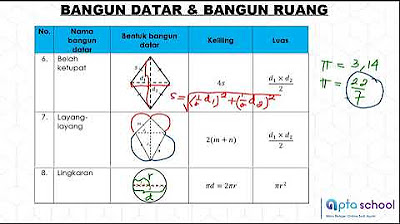Surface Area and Volume Review (Geometry)
Summary
TLDRThis video tutorial provides a clear and engaging overview of how to calculate the surface area and volume of various 3D shapes, including prisms, cylinders, pyramids, cones, and spheres. The presenter explains key formulas and uses easy-to-follow examples to demonstrate calculations. Viewers will learn how to group similar shapes together for easier memorization of formulas, and understand the difference between surface area and volume. The tutorial also provides helpful visual aids and tips for simplifying the process, making it an excellent resource for students preparing for exams like the SAT or ACT.
Takeaways
- 😀 Prisms and cylinders share similar volume and surface area formulas, making them easy to group together for calculations.
- 😀 The volume of a prism or cylinder is calculated as the area of the base multiplied by the height.
- 😀 For surface area of prisms and cylinders, the formula includes two bases and the perimeter of the base multiplied by the height.
- 😀 Pyramids and cones have one base and taper to a point, with their volume being one-third of the corresponding prism's volume.
- 😀 The surface area of pyramids and cones is the area of the base plus half the perimeter of the base multiplied by the slant height.
- 😀 The formula for the volume of a sphere is (4/3)πr³, where 'r' is the radius of the sphere.
- 😀 The surface area of a sphere is 4πr², again using the radius for calculation.
- 😀 Grouping shapes with similar properties, like prisms and cylinders or pyramids and cones, makes it easier to memorize formulas.
- 😀 The perimeter of a base is used in the surface area formulas for prisms, cylinders, pyramids, and cones, either multiplied by the height or the slant height.
- 😀 Remember that in volume calculations, the units will be cubed, while surface area calculations result in square units.
Q & A
What is a prism, and how is it different from a cylinder?
-A prism is a three-dimensional figure with two parallel and congruent bases. The height separates the two bases. A cylinder is grouped with prisms because it also has two bases, which are circular, and the height separates them, making it a type of circular prism.
How do you calculate the volume of a prism?
-The volume of a prism is calculated by multiplying the area of the base by the height. The formula is: Volume = Base Area × Height.
Why is the volume of a prism measured in cubic units?
-The volume of a prism is measured in cubic units because you're determining how much space it occupies, which is three-dimensional. For example, stacking small cubes (each of 1x1x1 unit) inside the prism gives the volume in cubic units.
What is the formula for the surface area of a prism?
-The surface area of a prism is calculated by the formula: Surface Area = 2 × Base Area + Perimeter of the Base × Height. This includes the areas of the two bases and the lateral surface area (the sides).
How is a triangular prism different from a square prism in terms of surface area?
-A triangular prism has triangular bases, and its surface area involves calculating the perimeter of the triangle base, multiplying it by the height, and adding the areas of the two triangular bases. A square prism has square bases, and its surface area involves the perimeter of the square base and the height, with two square areas added.
What is the key difference between the formulas for the volume of a pyramid and a cone?
-Both a pyramid and a cone share the same volume formula: Volume = 1/3 × Base Area × Height. The key difference is the shape of the base. Pyramids can have square or triangular bases, while cones have circular bases.
Why is the volume of a pyramid one-third of the volume of a prism with the same base and height?
-The volume of a pyramid is one-third of the volume of a prism because a pyramid has a tapered shape, and when placed inside a prism with the same base and height, it would fit exactly three pyramids in that prism.
How do you calculate the surface area of a cone?
-The surface area of a cone is calculated by the formula: Surface Area = πr² + πrL, where r is the radius of the base, and L is the slant height. The formula includes the area of the base (πr²) and the lateral surface area (πrL).
What is the formula for the volume of a sphere?
-The volume of a sphere is calculated using the formula: Volume = 4/3 × π × r³, where r is the radius of the sphere.
Why is the surface area of a sphere calculated using 4πr²?
-The surface area of a sphere is calculated using 4πr² because it's the area that would cover the entire outer surface of the sphere, similar to how the area of a circle (πr²) covers the flat surface of a circular shape. The factor of 4 accounts for the three-dimensional nature of the sphere.
Outlines

このセクションは有料ユーザー限定です。 アクセスするには、アップグレードをお願いします。
今すぐアップグレードMindmap

このセクションは有料ユーザー限定です。 アクセスするには、アップグレードをお願いします。
今すぐアップグレードKeywords

このセクションは有料ユーザー限定です。 アクセスするには、アップグレードをお願いします。
今すぐアップグレードHighlights

このセクションは有料ユーザー限定です。 アクセスするには、アップグレードをお願いします。
今すぐアップグレードTranscripts

このセクションは有料ユーザー限定です。 アクセスするには、アップグレードをお願いします。
今すぐアップグレード5.0 / 5 (0 votes)






